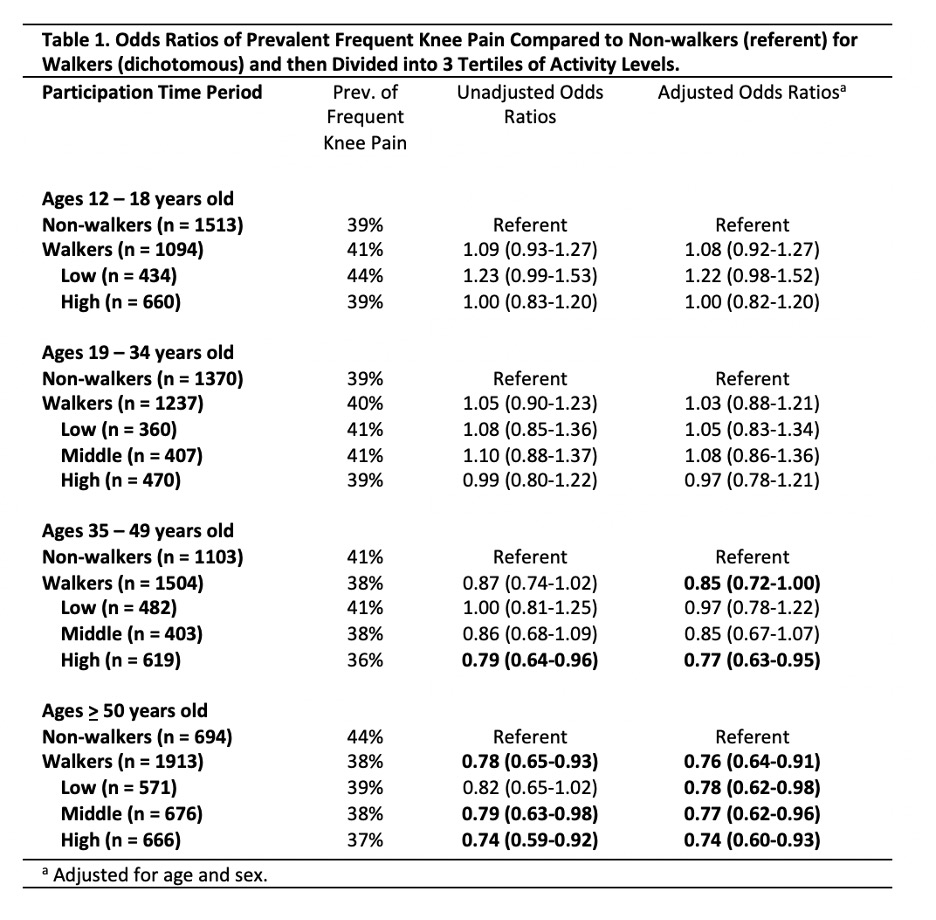Session Information
Session Type: Poster Session B
Session Time: 10:30AM-12:30PM
Background/Purpose: Osteoarthritis (OA) is the most common form of arthritis, with the knee being the most common joint involved. Exercise is a leading non-pharmacological treatment for OA. Walking is an easy, inexpensive, and readily available form of exercise. We aimed to evaluate the relationship of walking for exercise with prevalence of symptomatic knee OA in the Osteoarthritis Initiative (OAI), a community-based cohort that was not recruited based on walking status.
Methods: This is a retrospective cross-sectional study of OAI participants using knee x-ray readings, symptom assessments, and completed lifetime physical activity surveys defining walking status. All participants were asked to report if they walked for exercise during each of 4 periods in their life – ages 12-18, 19-34, 35-49 and >50 years old at the 96-month OAI follow-up visit. Participants were considered “walkers” if they walked for exercise (at least 10 times for at least 20 minutes per day). Further questions ascertained how many years, months, and times they participated to determine activity level, which was then divided into three tertiles of frequency (low, middle, high). Frequent knee pain (i.e., pain on most days of the past 30 days) was ascertained and PA semi-flexed knee radiographs were scored for Kellgren-Lawrence (KL) grade (0-4) at the 48-month follow-up visit. Radiographic OA (ROA) was defined as KL score ≥ 2. Symptomatic radiographic OA (SOA) required at least one knee with both ROA and frequent knee pain. Anyone with a total knee replacement was classified as having all outcomes. Logistic regression analyses were performed with walking for exercise as the predictor (over a lifetime and over each of the four age ranges). The outcomes were frequent knee pain, ROA, and SOA; presented crudely and then adjusted for age and sex.
Results: There were 2,607 participants, of which, 56% were female, the mean age was 64.3 (SD 9.0) years old, and the mean body mass index was 28.5 (SD 4.9) kg/m2. Eighty-one percent of the participants reported walking for exercise at some point in their lifetime. The frequency of walking for exercise increased with increasing age range. The most robust findings were in the group who walked for exercise when they were ages 50 and older as it related to frequent knee pain and SOA, with adjusted ORs of 0.76 (95% CI 0.64-0.91) and 0.70 (0.58-0.85) respectively (Tables 1 and 3).
Conclusion: In a cohort not recruited based on walking status, those in the 50 and older age range were less likely to have frequent knee pain and SOA, suggesting that those who walk are less likely to have knee symptoms. The more contemporaneous the activity is, the stronger the association is for walking with less knee pain, with or without knee OA. Findings from our study support that walking is potentially beneficial. Additional clinical trials are needed to confirm the effects of walking on knee health.
To cite this abstract in AMA style:
Tran S, Driban J, McAlindon T, Kriska A, Rockette-Wagner B, Eaton C, Hochberg M, Kwoh K, Nevitt M, Lo G. Walking Is Associated with Less Knee Pain: A Cross-sectional Study from the Osteoarthritis Initiative [abstract]. Arthritis Rheumatol. 2024; 76 (suppl 9). https://acrabstracts.org/abstract/walking-is-associated-with-less-knee-pain-a-cross-sectional-study-from-the-osteoarthritis-initiative/. Accessed .« Back to ACR Convergence 2024
ACR Meeting Abstracts - https://acrabstracts.org/abstract/walking-is-associated-with-less-knee-pain-a-cross-sectional-study-from-the-osteoarthritis-initiative/



